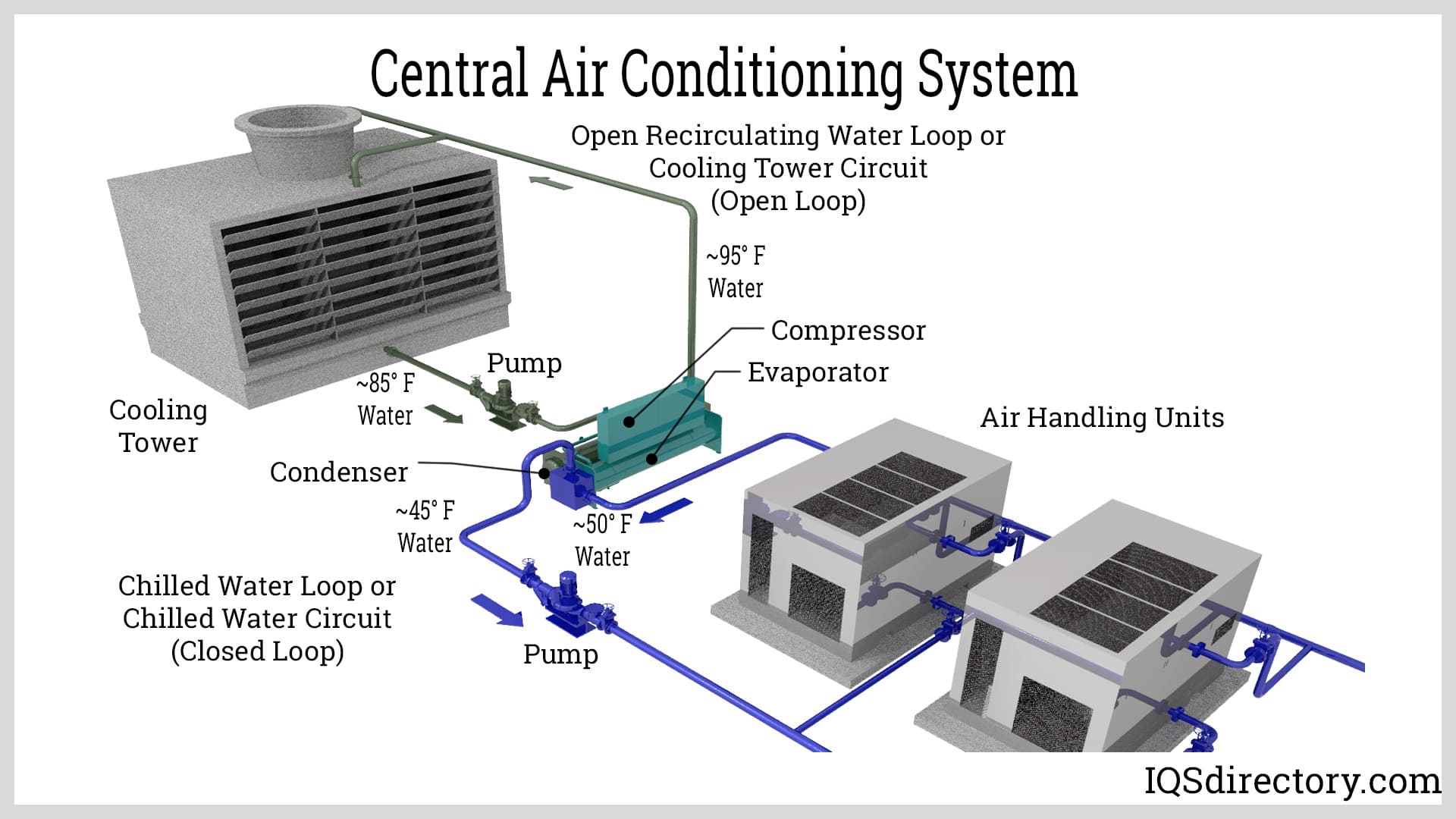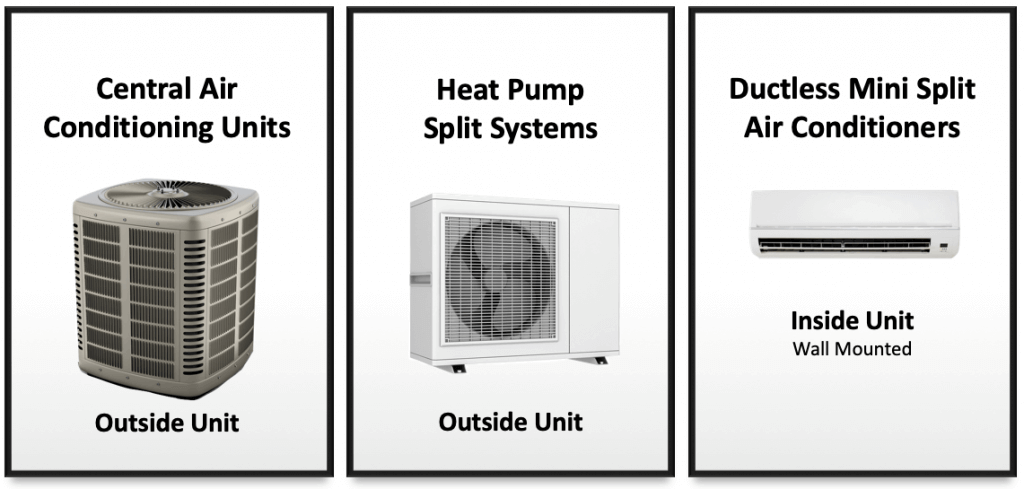Types Of Central Air Conditioning System

Frequently Asked Questions About Central Air Conditioning Systems
Central air conditioning is a significant investment for any home or business. Understanding the different types available can help you make an informed decision that suits your specific needs and budget. This FAQ addresses common questions about various central AC systems.
Q: What are the different types of central air conditioning systems?
There are primarily three main types of central AC systems:
- Split Systems: These are the most common type. They have two main components: an outdoor unit (containing the compressor and condenser) and an indoor unit (containing the evaporator coil and air handler).
- Package Systems: In a package system, all the components (compressor, condenser, evaporator coil, and air handler) are housed in a single outdoor unit.
- Ductless Mini-Split Systems: These systems don't require ductwork and consist of an outdoor unit connected to one or more indoor units mounted on walls or ceilings.
Each type has its own advantages and disadvantages, which we will explore further.
Q: What are the pros and cons of a split system air conditioner?
Split systems are a popular choice for many homes. Here's a breakdown of their advantages and disadvantages:
Pros:
- Cost-Effective: Generally, split systems are more affordable to install than package systems, especially if you already have existing ductwork.
- Quiet Operation: The noisy components (compressor and condenser) are located outside, resulting in quieter operation inside your home.
- Easy Maintenance: The separate components make maintenance and repairs easier to access.
- Versatile Installation: Split systems can be installed in various home layouts and sizes.
Cons:
- Requires Ductwork: If your home doesn't have existing ductwork, installation can be more expensive and complex.
- Potential for Ductwork Leaks: Ductwork can develop leaks over time, reducing efficiency and increasing energy costs.
- Aesthetic Considerations: The outdoor unit can be visually unappealing to some homeowners.
Q: How do package systems differ from split systems, and when are they a better choice?
The key difference is that package systems combine all the components – compressor, condenser, evaporator coil, and air handler – into a single, self-contained unit, typically located outdoors. Split systems, as mentioned before, separate these components into indoor and outdoor units.
Package systems are often a better choice in the following situations:
- Homes without existing ductwork: Package systems can be connected to ductwork relatively easily, making them a good option for homes that don't already have a duct system in place.
- Limited Indoor Space: When indoor space is at a premium, a package system eliminates the need for an indoor air handler unit.
- Commercial Buildings: Package systems are frequently used in commercial buildings with large, open spaces and rooftop installations.
- Replacement of an Existing Package System: If you're replacing an old package system, installing a new one is often the simplest and most cost-effective solution.
However, consider that package systems might be less energy-efficient and potentially louder inside the building because all components are located outside, and vibrations can transmit through the ductwork.
Q: What are ductless mini-split systems, and why are they gaining popularity?
Ductless mini-split systems offer a unique approach to central air conditioning. They consist of an outdoor unit (containing the compressor and condenser) connected to one or more indoor units (air handlers) mounted on walls or ceilings. These indoor units directly cool the air in the room, eliminating the need for ductwork.
Reasons for their increasing popularity include:
- No Ductwork Required: This makes them ideal for homes without existing ductwork, additions, or renovated spaces.
- Zoned Cooling: Each indoor unit can be controlled independently, allowing you to cool only the rooms you're using and save energy.
- Energy Efficiency: Ductless systems are often more energy-efficient than traditional ducted systems because they eliminate ductwork losses.
- Easy Installation: Installation is generally quicker and less disruptive than installing a ducted system.
- Improved Air Quality: Ductless systems often have advanced filtration systems, leading to improved indoor air quality.
While ductless systems offer many advantages, they can be more expensive to install upfront than traditional split systems, especially if you need multiple indoor units. Also, some people find the indoor units aesthetically unappealing.
Q: What is a heat pump, and how does it relate to central air conditioning?
A heat pump is a type of central air conditioning system that can both heat and cool your home. In the summer, it works like a traditional air conditioner, removing heat from inside and transferring it outside. In the winter, it reverses the process, extracting heat from the outside air (even when it's cold) and transferring it inside.
Key advantages of heat pumps include:
- Year-Round Comfort: Provides both heating and cooling in a single system.
- Energy Efficiency: Heat pumps are generally more energy-efficient than traditional electric resistance heating.
- Cost Savings: Can lower your energy bills compared to using separate heating and cooling systems.
However, heat pumps may not be as effective in extremely cold climates. As the outdoor temperature drops, their heating capacity decreases, and they may require supplemental heating to maintain a comfortable temperature. The efficiency of a heat pump is also impacted by how well the home is insulated.
Q: How do I choose the right size of central air conditioning system for my home or building?
Choosing the right size AC system is crucial for both comfort and efficiency. An undersized system won't be able to cool your space effectively, while an oversized system will cycle on and off frequently, leading to energy waste and potential equipment damage.
The best way to determine the right size is to have a professional HVAC contractor perform a load calculation. This calculation takes into account factors such as:
- Square footage: The size of the area to be cooled.
- Climate: The average temperature and humidity levels in your region.
- Insulation: The amount of insulation in your walls, ceilings, and floors.
- Windows: The number, size, and type of windows in your home.
- Sun exposure: The amount of sunlight that enters your home.
- Occupancy: The number of people who typically occupy the space.
- Heat-generating appliances: The presence of appliances like stoves, ovens, and computers.
The load calculation will determine the BTU (British Thermal Unit) requirement for your cooling system. Avoid relying solely on square footage; a professional assessment is the most reliable way to ensure you get the right size system.
Q: What is SEER rating, and why is it important?
SEER stands for Seasonal Energy Efficiency Ratio. It's a measure of an air conditioner's cooling efficiency over an entire cooling season. The higher the SEER rating, the more efficient the air conditioner is.
Why is the SEER rating important?
- Energy Savings: A higher SEER rating translates to lower energy bills. Even a small increase in SEER can result in significant savings over the lifespan of the system.
- Environmental Impact: More efficient air conditioners consume less energy, reducing your carbon footprint.
- Government Regulations: The U.S. Department of Energy sets minimum SEER standards for new air conditioners.
- Rebates and Incentives: Many utility companies and government agencies offer rebates and incentives for installing high-SEER air conditioners.
When choosing a central air conditioning system, pay close attention to the SEER rating. While higher SEER units typically have a higher upfront cost, the long-term energy savings can often offset the initial investment. Consider your budget and the climate in your region to determine the optimal SEER rating for your needs. As of 2023, the minimum SEER rating is 14 in most regions of the US, however depending on your location and type of unit the requirements may be different.

:max_bytes(150000):strip_icc()/what-are-central-air-conditioners-1152645_V2-390c6f1f6ca14b4ebc59426f226a78a8.png)








